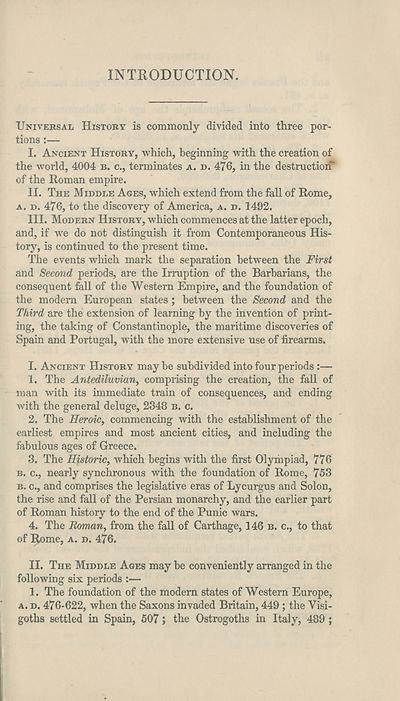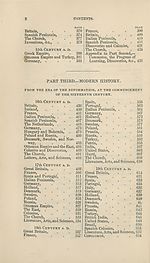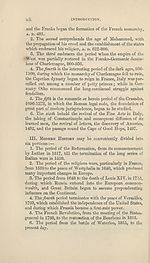Download files
Complete book:
Individual page:
Thumbnail gallery: Grid view | List view

INTRODUCTION.
Universal History is commonly divided into three por¬
tions :—
I. Ancient History, which, beginning with the creation of
the world, 4004 b. e., terminates a. d. 476, in the destructiorT
of the Roman empire.
II. The Middle Ages, which extend from the fall of Rome,
a. d. 476, to the discovery of America, a. d. 1492.
III. Modern History, which commences at the latter epoch,
and, if we do not distinguish it from Contemporaneous His¬
tory, is continued to the present time.
The events which mark the separation between the First
and Second periods, are the Irruption of the Barbarians, the
consequent fall of the Western Empire, and the foundation of
the modem European states ; between the Second and the
Third are the extension of learning by the invention of print¬
ing, the taking of Constantinople, the maritime discoveries of
Spain and Portugal, with the more extensive use of firearms.
I. Ancient History may be subdivided into four periods:—
1. The Antediluvian, comprising the creation, the fall of
man with its immediate train of consequences, and ending
with the general deluge, 2348 b. c.
2. The Heroic, commencing with the establishment of the
earliest empires and most ancient cities, and including the
fabulous ages of Greece.
3. The Historic, which begins with the first Olympiad, 776
b. c., nearly synchronous with the foundation of Rome, 753
b. c., and comprises the legislative eras of Lycurgus and Solon,
the rise and fall of the Persian monarchy, and the earlier part
of Roman history to the end of the Punic wars.
4. The Roman, from the fall of Carthage, 146 b. c., to that
of Rome, a. d. 476.
II. The Middle Ages may be conveniently arranged in the
following six periods :—
1. The foundation of the modem states of Western Europe,
a. d. 476-622, when the Saxons invaded Britain, 449; the Visi¬
goths settled in Spain, 507; the Ostrogoths in Italy, 489;
Universal History is commonly divided into three por¬
tions :—
I. Ancient History, which, beginning with the creation of
the world, 4004 b. e., terminates a. d. 476, in the destructiorT
of the Roman empire.
II. The Middle Ages, which extend from the fall of Rome,
a. d. 476, to the discovery of America, a. d. 1492.
III. Modern History, which commences at the latter epoch,
and, if we do not distinguish it from Contemporaneous His¬
tory, is continued to the present time.
The events which mark the separation between the First
and Second periods, are the Irruption of the Barbarians, the
consequent fall of the Western Empire, and the foundation of
the modem European states ; between the Second and the
Third are the extension of learning by the invention of print¬
ing, the taking of Constantinople, the maritime discoveries of
Spain and Portugal, with the more extensive use of firearms.
I. Ancient History may be subdivided into four periods:—
1. The Antediluvian, comprising the creation, the fall of
man with its immediate train of consequences, and ending
with the general deluge, 2348 b. c.
2. The Heroic, commencing with the establishment of the
earliest empires and most ancient cities, and including the
fabulous ages of Greece.
3. The Historic, which begins with the first Olympiad, 776
b. c., nearly synchronous with the foundation of Rome, 753
b. c., and comprises the legislative eras of Lycurgus and Solon,
the rise and fall of the Persian monarchy, and the earlier part
of Roman history to the end of the Punic wars.
4. The Roman, from the fall of Carthage, 146 b. c., to that
of Rome, a. d. 476.
II. The Middle Ages may be conveniently arranged in the
following six periods :—
1. The foundation of the modem states of Western Europe,
a. d. 476-622, when the Saxons invaded Britain, 449; the Visi¬
goths settled in Spain, 507; the Ostrogoths in Italy, 489;
Set display mode to:
![]() Universal Viewer |
Universal Viewer | ![]() Mirador |
Large image | Transcription
Mirador |
Large image | Transcription
| Antiquarian books of Scotland > Education > Elements of universal history on a new and systematic plan > (19) |
|---|
| Permanent URL | https://digital.nls.uk/127580368 |
|---|
| Description | Thousands of printed books from the Antiquarian Books of Scotland collection which dates from 1641 to the 1980s. The collection consists of 14,800 books which were published in Scotland or have a Scottish connection, e.g. through the author, printer or owner. Subjects covered include sport, education, diseases, adventure, occupations, Jacobites, politics and religion. Among the 29 languages represented are English, Gaelic, Italian, French, Russian and Swedish. |
|---|

